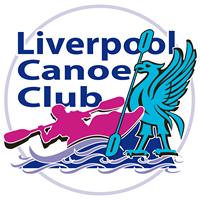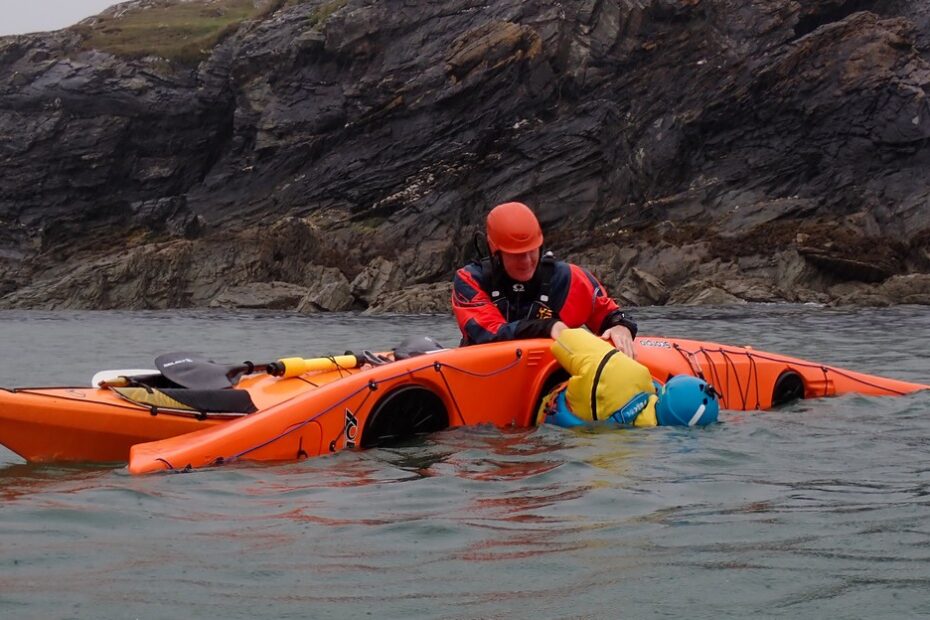Sea Kayak Safety and Rescue Coaching Session
On Saturday, 10 club members and four club coaches assembled at Porth Dafarch for an opportunity to get some valuable coaching on Sea Kayak rescue techniques. The pre-ordered sun decided not to turn up, instead, we were treated to a day of rain and wind which was a blessing considering we were all dressed for immersion and would have sweltered if the sun had shone.

This session was meant to be the second part of a two-session series, however, six of the ten weren’t able to attend the first session. We therefore split the session with us re-running the first day’s coaching for those who hadn’t attended whilst allowing the four who had to progress without having to fully repeat their last session. Briefings and introductions were quickly conducted, a good mix of new faces and trip regulars.
Martin’s emails the night before had reminded everyone that helmets would be compulsory for the session, so it was a good sign that everyone had their brightly coloured helmets fixed in place before we got onto the water.
The on-water coaching began with a demonstration and walk-through of a deep-water rescue, I’d been volunteered to be the victim for the casualty so unceremoniously was the first to get wet wet, and not just rain wet. Martin’s rescue demonstration was smooth and clearly explained to those watching, highlighting the importance of checking the ‘victim’ was OK and safe before proceeding to empty their boat. Once my kayak was empty and I’d heel-hooked myself back into the dry(ish) cockpit there was a quick Q&A before we split off to practice.
I’ve recently qualified as a Sea Kayak Leader and I’m looking to consolidate my coaching experience before getting my skills assessed, so I was very grateful to have the opportunity to coach and supervise one of the groups of three. Martin took the rest of those doing ‘day one’ while Nikki took those doing ‘day two’. Ian had the luxury of floating between the groups to supervise and impart some of his wisdom here and there.

My group were all really enthusiastic about getting going so it wasn’t long before we had someone in the water waiting to be rescued – they each took turns to rescue, be rescued and to watch. After each rescue, the group took turns to constructively critique the rescues from each of their points of view. After the first round was completed we had a few things to work on… speeding up the approach and initial contact with the victim’s boat, having a good way to stow paddles during the rescue, communication during the rescue and how best to steady the victims kayak when they were heel-hooking back in.
Despite it raining quite heavily everyone was warm and comfortable enough so we took some time to discuss what makes a ‘good’ victim and how the victim playing a proactive role in their rescue can make it so much easier (and stop it getting VERY much harder)… we covered turning over your kayak, keeping hold of your equipment and making your way to the end of the kayak closest to the rescuer.
In the second round of practices, there was a definite improvement in the confidence and performance of the rescues. All second rescues were quicker and smoother than the first! Result! By this time it was definitely ‘lunch o’clock’, especially considering we broke the almost mandatory club requirement for multiple elevenses! Over lunch, there was further discussion on the many successes of the morning with a consensus about regular practice being required to keep the skills slick for when they may be really required.

The coaches discussed the common themes within their groups and boat handling during the initial contact of the rescue was on all of our lists. So after lunch to re-warm up, Martin ran a few exercises on boat handling and manoeuvrability. Splitting the group into pairs to paddle around each other’s kayaks, first forward them backwards, before then getting into larger groups to do figure-of-eights around each other.
With the muscles now warmed we move onto assisted rescues, which are a modification of a standard deep-water rescue where a third paddler assists the victim back into their kayak. As per the morning, this was demonstrated by myself and Martin, but this time Ian drew the short straw of playing victim. With the deep-water rescue practice from the morning still fresh in the minds of everyone, the assisted rescues proved to be fairly straightforward with everyone in my group performing them with aplomb.
The next assisted rescue demonstrated was the ‘scoop’ rescue which is usually used if the victim has suffered a shoulder injury and is unable to use their upper body to re-enter the kayak. This rescue involves partially flooding the victims cockpit and having them slide into it whilst it is partially submerged. Once the victim is firmly seated, the rescuer then rolls the kayak back upright and the victim is able to sit upright. This can be a tough one to master and requires the victim to be firmly in their seat and for the rescuer to use their bodyweight to rotate the kayak. All of my group managed to get the victim safely upright… however, they weren’t as smooth as all had hoped. Definitely one that needs practice to nail the technique.

The final rescue we coached was the ‘hand of god’ rescue, which is used to right a kayak if the victim is entrapped by their spray deck or unconscious and unable to exit the cockpit. It’s the one rescue that all leaders dread having to perform for real, but the time-sensitivity that would be involved in a real incident highlights the need for practising it and getting the technique nailed. It’s a rescue that might actually be easier to perform for real rather than in practice though… given that the person playing victim has to play at being unconscious, if they don’t then they make it significantly more difficult (ahem… Terry!). The technique itself involves positioning your kayak alongside the upturned kayak before reaching over and rotating the kayak to an upright position. It’s a rescue where it benefits to be larger as you can really use your weight and reach to make the move easier, however, good technique means that even smaller paddlers can perform it on larger people.
Now the wind was starting to build, so we had a quick afternoon elevenses. During the quick break, we discussed contact towing – what it was, the situations where you would use it and the pros/cons of using equipment… all topped off with an awkward (but effective) dry-land demonstration by me and Martin. Martin then handed out make-shift contact towlines to those who didn’t have their own. The concepts were quickly understood and everyone headed back to the water in pairs to begin practicing. It’s a relatively important skill to have, as its usage is usually in time-sensitive or space-restricted rescues – so knowing both sides of being rescuer and victim is vital for the budding sea kayaker.
Before we knew it, it was almost 1600 and we’d yet to leave the bay… so myself and Martin took our groups out of the bay to experience some of the building conditions… one slight problem, as soon as we’d decided to do this the wind decided it was done for the day and the conditions dissipated. Weather ay?! We still took the opportunity to do a short paddle with a bit of rock hopping along the coast. Nicky’s group were out with their long towlines towing rafts and inline tows – maybe next time for my group.

Back in the bay we landed and carried the kayaks up the beach in pairs. Then we held a quick debrief recapping what we’d covered throughout the day, highlighting the importance of finding time to practice the skills and the role that knowing them plays in becoming a ‘competent group member’.

